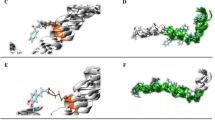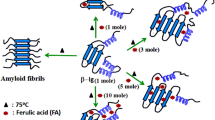Abstract
Flavonoids are polyphenol compounds abundantly found in plants and reported to have an inhibitory effect on amyloid fibrillation. The number and position of hydroxyl groups, as well as the arrangement of flavonoids rings, may influence their inhibitory effects. In this study, we investigate the effect of structural characteristics of flavonoids on amyloid fibril formation. For this purpose, five compounds (i.e., biochanin A, daidzein, quercetin, chrysin and fisetin) were selected that represent a variety in the number and position of their hydroxyl groups. The inhibitory effect of these flavonoids on the amyloid fibril formation of apo-carbonic anhydrase (apo-BCA), as a model protein, was evaluated using thioflavin T and transmission electron microscopy. The results showed that fisetin possessed the most significant inhibitory effect. Interestingly, upon apo-BCA acetylation, none of the tested flavonoids could inhibit the fibrillation process, which indicates that the interactions of these compounds with the amine groups of lysine residues could be somewhat important.





Similar content being viewed by others
Abbreviations
- BCA II:
-
bovine carbonic anhydrase II
- ThT:
-
thioflavin T
- TEM:
-
transmission electron microscope
- DMSO:
-
dimethyl sulfoxide
- apo-BCA-Ac:
-
apo-acetylated bovine carbonic anhydrase
- EGCG:
-
epigallocatechin gallate
References
Akaishi T, Morimoto T, Shibao M, Watanabe S, Sakai-Kato K, Utsunomiya-Tate N and Abe K 2008 Structural requirements for the flavonoid fisetin in inhibiting fibril formation of amyloid β protein. Neurosci. Lett. 444 280–285
Antzutkin ON, Leapman RD, Balbach JJ and Tycko R 2002 Supramolecular structural constraints on Alzheimer’s β-amyloid fibrils from electron microscopy and solid-state nuclear magnetic resonance. Biochemistry 41 15436–15450
Azami-Movahed M, Shariatizi S, Sabbaghian M, Ghasemi A, Ebrahim-Habibi A and Nemat-Gorgani M 2013 Heme binding site in apomyoglobin may be effectively targeted with small molecules to control aggregation. Int. J. Biochem. Cell. Biol. 45 299–307
Bieschke J, Russ J, Friedrich RP, Ehrnhoefer DE, Wobst H, Neugebauer K and Wanker EE 2010 EGCG remodels mature α-synuclein and amyloid-β fibrils and reduces cellular toxicity. Proc. Natl. Acad. Sci. USA 107 7710–7715
Bushmarina NA, Kuznetsova IM, Biktashev AG, Turoverov KK and Uversky VN 2001 Partially folded conformations in the folding pathway of bovine carbonic anhydrase II: a fluorescence spectroscopic analysis. Chembiochem. 2 813–821
Chandrashekaran IR, Adda CG, MacRaild CA, Anders RF and Norton RS 2010 Inhibition by flavonoids of amyloid-like fibril formation by Plasmodium falciparum merozoite surface protein 2. Biochemistry 49 5899–5908
Chinisaz M, Ebrahim-Habibi A, Dehpour A-R, Yaghmaei P, Parivar K and Moosavi-Movahedi AA 2017 Structure and function of anhydride-modified forms of human insulin: In silico, in vitro and in vivo studies. Eur. J. Pharm. Sci. 96 342–350
Chiti F and Dobson CM 2006 Protein misfolding, functional amyloid, and human disease. Annu. Rev. Biochem. 75 333–366
Cisek K, Cooper GL, Huseby CJ and Kuret J 2014 Structure and mechanism of action of tau aggregation inhibitors. Curr. Alzheimer Res. 11 918–927
Cohen TJ, Guo JL, Hurtado DE, Kwong LK, Mills IP, Trojanowski JQ and Lee VM 2011 The acetylation of tau inhibits its function and promotes pathological tau aggregation. Nat. Commun. 2 252.
Doig AJ and Derreumaux P 2015 Inhibition of protein aggregation and amyloid formation by small molecules. Curr. Opin. Struct. Biol. 30 50–56
Es-haghi A, Shariatizi S, Ebrahim-Habibi A and Nemat-Gorgani M 2012 Amyloid fibrillation in native and chemically-modified forms of carbonic anhydrase II: role of surface hydrophobicity. Biochim. Biophys. Acta 1824 468–477
Feng Y, Wang X-P, Yang S-G, Wang Y-J, Zhang X, Du X-T, Sun X-X, Zhao M, Huang L and Liu R-T 2009 Resveratrol inhibits beta-amyloid oligomeric cytotoxicity but does not prevent oligomer formation. Neurotoxicology 30 986–995
Feng S, Song X-H and Zeng C-M 2012 Inhibition of amyloid fibrillation of lysozyme by phenolic compounds involves quinoprotein formation. FEBS Lett. 586 3951–3955
Ferreira N, Cardoso I, Domingues MR, Vitorino R, Bastos M, Bai G, Saraiva MJ and Almeida MR 2009 Binding of epigallocatechin‐3‐gallate to transthyretin modulates its amyloidogenicity. FEBS Lett. 583 3569–3576
Ferreira N, Saraiva MJ and Almeida MR 2011 Natural polyphenols inhibit different steps of the process of transthyretin (TTR) amyloid fibril formation. FEBS Lett. 585 2424–2430
Fink AL 1998 Protein aggregation: folding aggregates, inclusion bodies and amyloid. Fold. Des. 3 R9–R23
Funk KE, Thomas SN, Schafer KN, Cooper GL, Liao Z, Clark DJ, Yang AJ and Kuret J 2014 Lysine methylation is an endogenous post-translational modification of tau protein in human brain and a modulator of aggregation propensity. Biochem. J. 462 77–88
Gitlin I, Gudiksen KL and Whitesides GM 2006 Effects of surface charge on denaturation of bovine carbonic anhydrase. Chembiochem. 7 1241–1250
Hirohata M, Hasegawa K, Tsutsumi-Yasuhara S, Ohhashi Y, Ookoshi T, Ono K, Yamada M and Naiki H 2007 The anti-amyloidogenic effect is exerted against Alzheimer’s β-amyloid fibrils in vitro by preferential and reversible binding of flavonoids to the amyloid fibril structure. Biochemistry 46 1888–1899
Hong D-P, Fink AL and Uversky VN 2008 Structural characteristics of α-synuclein oligomers stabilized by the flavonoid baicalein. J. Mol. Biol. 383 214–223
Ishige K, Schubert D and Sagara Y 2001 Flavonoids protect neuronal cells from oxidative stress by three distinct mechanisms. Free Radicals Biol. Med. 30 433–446
Kim H, Park B-S, Lee K-G, Choi CY, Jang SS, Kim Y-H and Lee S-E 2005 Effects of naturally occurring compounds on fibril formation and oxidative stress of β-amyloid. J. Agric. Food Chem. 53 8537–8541
Krebs MR, Bromley EH and Donald AM 2005 The binding of thioflavin-T to amyloid fibrils: localisation and implications. J. Struct. Biol. 149 30–37
Kummer MP, Hermes M, Delekarte A, Hammerschmidt T, Kumar S, Terwel D, Walter J, Pape H-C, König S and Roeber S 2011 Nitration of tyrosine 10 critically enhances amyloid β aggregation and plaque formation. Neuron 71 833–844
Lashuel HA, Hartley DM, Balakhaneh D, Aggarwal A, Teichberg S and Callaway DJ 2002 New class of inhibitors of amyloid-β fibril formation implications for the mechanism of pathogenesis in Alzheimer’s disease. J. Biol. Chem. 277 42881–42890
Li J, Zhu M, Rajamani S, Uversky VN and Fink AL 2004 Rifampicin inhibits α-synuclein fibrillation and disaggregates fibrils. Chem. Biol. 11 1513–1521
Li W, Sperry JB, Crowe A, Trojanowski JQ, Smith AB III and Lee VMY 2009 Inhibition of tau fibrillization by oleocanthal via reaction with the amino groups of tau. J. Neurochem. 110 1339–1351
Marshall KE, Morris KL, Charlton D, O’Reilly N, Lewis L, Walden H and Serpell LC 2011 Hydrophobic, aromatic, and electrostatic interactions play a central role in amyloid fibril formation and stability. Biochemistry 50 2061–2071
Ngoungoure VLN, Schluesener J, Moundipa PF and Schluesener H 2015 Natural polyphenols binding to amyloid: a broad class of compounds to treat different human amyloid diseases. Mol. Nutr. Food Res. 59 8–20
Nilsson MR and Dobson CM 2003 Chemical modification of insulin in amyloid fibrils. Protein Sci. 12 2637–2641
Otero-Romaní J, Moreda-Piñeiro A, Bermejo-Barrera P and Martin-Esteban A 2009 Inductively coupled plasma-optical emission spectrometry/mass spectrometry for the determination of Cu, Ni, Pb and Zn in seawater after ionic imprinted polymer based solid phase extraction. Talanta 79 723–729
Ozensoy O, Arslan O and Sinan SO 2004 A new method for purification of carbonic anhydrase isozymes by affinity chromatography. Biochemistry (Moscow) 69 216–219
Porat Y, Abramowitz A and Gazit E 2006 Inhibition of amyloid fibril formation by polyphenols: structural similarity and aromatic interactions as a common inhibition mechanism. Chem. Biol. Drug Des. 67 27–37
Pratim Bose P, Chatterjee U, Xie L, Johansson J, Göthelid E and Arvidsson PI 2010 Effects of Congo red on Aβ1−40 fibril formation process and morphology. ACS Chem. Neurosci. 1 315–324
Ross CA and Poirier MA 2004 Protein aggregation and neurodegenerative disease. Nat. Med. 10 S10
Saito R, Sato T, Ikai A and Tanaka N 2004 Structure of bovine carbonic anhydrase II at 1.95 Å resolution. Acta Crystallogr. D Biol. Crystallogr. 60 792–795
Schmitt A, Schmitt J, Münch G and Gasic-Milencovic J 2005 Characterization of advanced glycation end products for biochemical studies: side chain modifications and fluorescence characteristics. Anal. Biochem. 338 201–215
Soto C, Sigurdsson EM, Morelli L, Kumar RA, Castaño EM and Frangione B 1998 β-sheet breaker peptides inhibit fibrillogenesis in a rat brain model of amyloidosis: implications for Alzheimer’s therapy. Nat. Med. 4 822–826
Stefani M and Rigacci S 2013 Protein folding and aggregation into amyloid: the interference by natural phenolic compounds. Int. J. Mol. Sci. 14 12411–12457
Sunde M and Blake C 1997 The structure of amyloid fibrils by electron microscopy and X-ray diffraction. Adv. Protein Chem. 50 123–159
Torok B, Dasgupta S and Torok M 2008 Chemistry of small molecule inhibitors in self-assembly of Alzheimer’s disease related amyloid-beta peptide. Curr. Bioact. Compd. 4 159–174
Tsao R 2010 Chemistry and biochemistry of dietary polyphenols. Nutrients 2 1231–1246
Wang SS-S, Chen Y-T and Chou S-W 2005 Inhibition of amyloid fibril formation of β-amyloid peptides via the amphiphilic surfactants. Biochim. Biophys. Acta 1741 307–313
Wong K-P and Tanford C 1973 Denaturation of bovine carbonic anhydrase B by guanidine hydrochloride A process involving separable sequential conformational transitions. J. Biol. Chem. 248 8518–8523
Wong YQ, Binger KJ, Howlett GJ and Griffin MD 2010 Methionine oxidation induces amyloid fibril formation by full-length apolipoprotein AI. Proc. Natl. Acad. Sci. USA 107 1977–1982
Yang F, Lim GP, Begum AN, Ubeda OJ, Simmons MR, Ambegaokar SS, Chen PP, Kayed R, Glabe CG and Frautschy SA 2005 Curcumin inhibits formation of amyloid β oligomers and fibrils, binds plaques, and reduces amyloid in vivo. J. Biol. Chem. 280 5892–5901
Yarnall AJ, Lashley T, Ling H, Lees AJ, Coleman SY, O’Sullivan SS, Compta Y, Revesz T and Burn DJ 2016 Apomorphine: a potential modifier of amyloid deposition in Parkinson’s disease? Mov. Disord. 31 668–675
Acknowledgements
This work was supported by grants from the research council of the University of Tehran and the Iranian National Science Foundation (INSF). The technical assistance kindly provided by Ms. A. Ghasemi is gratefully acknowledged.
Author information
Authors and Affiliations
Corresponding author
Additional information
Corresponding editor: BJ Rao
Rights and permissions
About this article
Cite this article
Es-haghi, A., Ebrahim-Habibi, A. Inhibition of amyloid fibrillation of apo-carbonic anhydrase by flavonoid compounds. J Biosci 44, 46 (2019). https://doi.org/10.1007/s12038-019-9866-6
Received:
Accepted:
Published:
DOI: https://doi.org/10.1007/s12038-019-9866-6




